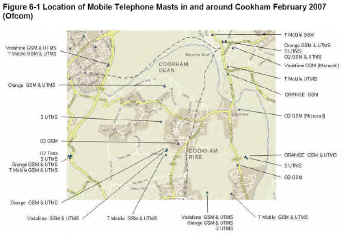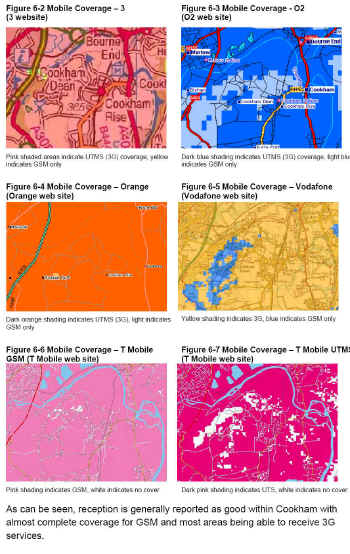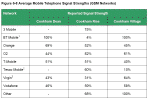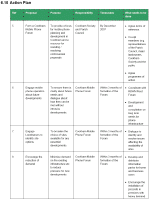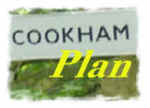
The Cookham Plan
Findings and Recommendations
Housing and Development Group
6. MOBILE TELEPHONES
| MAIN REPORT INDEX | HOUSING AND DEVELOPMENT INDEX |
6 MOBILE TELEPHONES
6.1 Remit
Consider the issues associated with the siting of mobile telephone masts.
6.2 Background
Although mobile telephones are now a widely used and important part of life, the siting of base stations and masts provokes great controversy on both health and aesthetic grounds. Mobile telephone companies are required by their
government granted licences to achieve specified levels of population coverage (for example 80% of the UK population by December 2007 for 3G networks) and they are given both access to highway authority land and concessions within the planning process to assist them in doing this. The drive for increased coverage coupled with the relative ease of gaining permission means that mast development proposals are a regular and unwelcome feature of life for many
people.
Cookham has been subject to a number of proposals over the years and pressure for further installations is likely to continue in the future. In order to address this issue in the plan, we need to start with a clear understanding of
how mobile telephones work, current coverage, potential developments, the planning process and factors affecting the choice of sites for masts.
6.3 How do mobiles work?
The All Party Parliamentary Mobile Group considered mobile phone masts in their July 2004 report ( 6.1). This provides a useful description of how mobile telephone systems work:
Mobile phones operate on a system of cells, each cell supported by a radio base station, which is a facility that provides transmission and reception for radio systems. Each of the five mobile phone operators divides the UK into
thousands of individual geographic areas or 'cells'. The cells overlap at the edges to prevent holes in coverage. There are three types of cell:
-
macrocells which provide the main structure for the base station network with a range of up to 35 kilometres;
-
microcells which infill and improve the main network, with a range of up to a few hundred metres; and
-
picocells which have a much smaller range and are used in busy areas such as inside buildings, airports and shopping centres.
The systems are demand-led, and to achieve coverage, each cell has to be provided with a base station, which hands the calls over from one area to another. If they are too far apart, calls are interrupted or dropped when mobile
phone users are on the move. Increased usage of mobile phones also results in a higher demand for base stations, as each has a limited capacity, and this can be expanded by the addition of more base stations within macrocells or
microcells.
Radio base stations are commonly called masts, and although the terms are used interchangeably, they are in fact two different things. Radio base stations are sites that enable mobile phones to work. They can be big or small, and
always have transmitters or receivers in a cabin or cabinet connected to antennas nearby. A base station (i.e. transmitters, receivers and antennas) can be mounted on a large mast or tower, on existing buildings, rooftops or in street furniture. There are currently about 40,000 radio base stations in the UK.
Strictly speaking, a mast is the freestanding structure which supports antennas at a height where they can transmit and receive radio waves. A mast is typically 15m high and plays no part in itself in the transmission of radio waves.
A mobile phone is a low-powered two-way radio, converting human voice and data messages into radio waves. When making a call, the radio signals are transmitted from the mobile phone to the nearest base station. Once a signal
reaches a base station it is then transmitted to the main telephone network where it is transferred to the network of the person receiving the call. The cells in a new third generation (3G) network will be smaller because 3G uses a higher radio frequency. These cells also expand and contract in size depending on the number of simultaneous calls being made. For this reason, 3G cells will have to overlap more than the current 2G cells, and although it is anticipated that operators will be able to re-use some of their existing infrastructure, they will also need to develop a substantial number of new sites.
There are at present 3 main systems in use in Britain. These are:
-
3G (technically known as UTMS or Universal Mobile Telecommunications Service) - the latest system which allows video calling and fast access to the internet.
-
GSM (Global System for Mobile communications or 2G) - the older digital system on which most mobiles work. 3G phones use GSM when UTMS is not available.
-
TETRA (Terrestrial Trunked Radio)- an alternative digital system which covers a range of private networks - e.g. for the emergency services.
6.4 Current Coverage
Mobile telephone providers are regulated by OFCOM who provide details of mast locations on their web site at http://www.sitefinder.ofcom.org.uk/. Figure 6-1 shows the location of masts around Cookham. The figure includes the
positions of masts which service the UTMS (3G), GSM (2G) and TETRA networks.
The mobile telephone companies also produce maps showing their local coverage. These are included in Figure 6-2, Figure 6-3, Figure 6-4, Figure 6-5, Figure 6-6 and Figure 6-7.
Figure 6-1 Location of Mobile Telephone Masts in and around Cookham February 2007 (Ofcom)
click on map for larger image
Figure 6-2 Mobile Coverage – 3 (3 website)
Figure 6-3 Mobile Coverage - O2 (O2 web site)
Figure 6-4 Mobile Coverage – Orange (Orange web site)
Figure 6-5 Mobile Coverage – Vodafone (Vodafone web site)
Figure 6-6 Mobile Coverage – T Mobile GSM (T Mobile web site)
Figure 6-7 Mobile Coverage – T Mobile UTMS (T Mobile web site)
click on maps below for larger image
As can be seen, reception is generally reported as good within Cookham with almost complete coverage for GSM and most areas being able to receive 3G services.
Residents were asked to confirm their experience of mobile telephone signal strengths in the Cookham Plan Questionnaire. 609 responses were received to question 13 which asked people to report the signal strength for any applicable networks in and around their homes. Responses were expressed as a percentage of the maximum possible signal strength indicated by their handset (e.g. 3 out of 5 bars represents 60%). The results are shown in Figure 6-8 and Figure 6-9. These appear to bear out the operators maps which show that there is generally good coverage across Cookham. Given the extent of choice available to consumers, it seems reasonable that most residents should be able
to obtain a reasonable signal strength at home should they need to.
Figure 6-8 Average Mobile Telephone Signal Strengths (GSM Networks)N
click on charge for larger image
Figure 6-9 Average Mobile Telephone Signal Strengths (UTMS (3G) Networks)
click on charge for larger image
There were only 42 responses for 3G networks which presumably reflects the relative newness of this technology. Nevertheless, this appears to indicate that there is a generally acceptable level of signal for these services.
6.5 Potential Developments
6.5.1 Demand
It is very difficult to anticipate how the use of mobile telephones may change over the 10 to 20 year period of the Cookham Plan. In the short to medium term, it seems likely that demand for new handsets will slow as the market becomes saturated but against this, new applications may emerge as technology changes (for example, as a part of future road pricing systems). It also seems likely that demand will transfer from GSM to 3G if price levels fall and handsets become more able to access web based material. This suggests that there may be continued pressure to
build new 3G masts given the shorter ranges, more limited capacity and reduced cell sizes associated with them.
Further increases in local demand for mobile telephony could come from increases in home working or in the bandwidth requirements of visitors to Cookham (for example the use of mobile computing by visitors to the Odney Club and Moor Hall).
6.5.2 Technology
In the longer term, demand will stabilise and it is likely that there will be some consolidation amongst operators. Such a scenario could lead to a reduction in mast sites as companies seek to cut costs by reducing their infrastructure.
Against this is the likelihood that a new generation of mobile technology will emerge offering higher data download speeds and / or reduced transmission power will emerge. It is to be hoped that such developments could re-use the existing infrastructure rather than needing a brand new network like 3G did.
Over and above these possibilities, there may be step changes in technology arising from (for example) greater integration between WiFi access points and mobile telephony or greater use of satellite systems.
The impact of these on Cookham is almost impossible to foresee at this time.
6.6 The Planning Process
Under the Telecommunications Act 1984 and the Communications Act 2003, mobile telephone companies have powers granted to them by Ofcom which allow them to construct infrastructure on public land (i.e. roads and streets) and
to take rights over private land. These powers are set out in the Electronic Communications Code (ECC)( 6.2) and they include certain relaxations of planning requirements where the infrastructure can be classified as ‘permitted development’. In general terms:
-
Masts over 15 metres in height, and any masts in Conservation Areas, require planning permission.
-
Permitted development rights apply to smaller scale telecommunications development. For example, masts up to 15 metres in height require an application for prior approval of the siting and appearance proposed. Prior approval applications have to be determined within 56 days or they are automatically allowed.
-
Small scale developments are not subject to planning control. Examples could include the installation of additional antennas on an existing radio mast, base stations on buildings and equipment cabinets with a volume less than 2.5 cubic metres.
Whichever planning route a development follows, there is little doubt that many local residents hold real fears about its appearance, effect on house prices and on their safety. Unfortunately, the last two of these factors are not taken into
account under present planning laws.
6.7 Health and Safety concerns
So far, this review has dealt mainly with factual matters but as we move tohealth and safety concerns we encounter a combination of fact and emotion.
On the emotional side, people are concerned about the potential effect of radio transmissions and of long term exposure to them. Not withstanding that there has been over 50 years of radio and television transmission from much more powerful antennae and with no reported ill effects and that most people are prepared to use mobile handsets (which produce higher levels of exposure than typically arise from masts), there are still significant numbers of people who hold deep seated concerns about the safety of masts.
To date, the main source of information about the safety of mobile telephones has come from the Stewart Report( 6.3). Published in 2000 under the Chairmanship of Sir William Stewart, the report of the Independent Expert
Group on Mobile Phones considered the effects on human health of handsets, base stations and transmitters. The report recognised that, with mobile phone technology still in its early stages, potential effects remain largely unknown.
Given the impossibility of proving that mobile phone systems are safe and that time will be required to discover if they pose any specific risks, the report recommended a precautionary approach in all matters (including the use of
handsets). Findings of particular relevance to the Cookham Plan were:
-
The siting of base stations in residential areas can cause considerable concern and distress. Adverse impacts on the local environment may adversely impact on the public’s well being as much as any direct health effects.
-
There is significant variability in the extent to which mobile phone operators consult the public on the siting of base stations. Protocols should be developed.
-
‘Permitted development’ rights should be revoked and the siting of all new base stations should be subject to the normal planning process.
-
In relation to macrocell base stations sited within or near to school grounds, the beam of greatest intensity from the aerials should not fall on any part of the grounds or buildings without agreement from the school and parents.
-
In making decisions about the siting of base stations, radio frequency fields to which the public will be exposed should be kept to the lowest practical levels commensurate with the telecommunications system operating effectively.
-
Operators should actively pursue a policy of mast sharing and roaming where practicable to reduce the number of mast sites required.
Although a number of these points would require legislation to be enforceable, they provide a useful framework for considering how mobile telephone infrastructure development around Cookham may be managed in the future.
6.8 Factors to be considered in siting masts
From a telephone company’s point of view, the main factors influencing the choice of sites are:
-
Coverage - how many customers can be reached? This means that operators generally favour more exposed sites which are not obstructed by buildings, trees, hills etc.
-
Cost - what is the cost of the site to buy or rent and of the infrastructure (cabling, roads, fencing etc) required? Under the ECC, permission for the installation of equipment must be given by the landowner and, in the absence of agreement, may be granted by the County Court. For highways land, permission is granted by the relevant ‘street manager’ which for Cookham is the borough council in its role as highway authority. RBWM were requested to provide details of the criteria used in granting permission during the preparation of this report but failed to respond to our enquiries.
-
Planning - national and local planning considerations determine where development will be acceptable.
6.8.1 National planning guidance
National Planning guidance is given in Planning Policy Guidance 8: Telecommunications (PPG8)( 6.4). The main factors to be considered are:
-
There should be pre-application discussions between the operator and the local planning authority, organisations with an interest in the development and local residents. Local Authorities should ensure there is adequate publicity to give people an opportunity to express their views.
-
Both the authority and the operator should consult any schools near to proposed transmitters.
-
Protection from visual intrusion is important and planning authorities and operators should work together to find optimum environmental and network solutions.
-
Development in the Green Belt is inappropriate unless it ‘maintains openness’. Development may, however, be permitted in special circumstances such as a lack of alternative sites.
-
Sharing of masts and sites is strongly encouraged (unless there are technical or environmental problems).
-
Operators should demonstrate that existing buildings or structures cannot be used before applying for new sites.
-
Local authorities should help operators to identify sites by making their property available and encouraging others to do the same.
-
Design and camouflage should be used to minimise the effect of masts on the environment.
-
Health considerations are not relevant provided that the development complies with ICNIRP emission standards.
-
Local authorities cannot impose precautionary measures beyond those set out in the Stewart Report and accepted by the Government.
Overarching all of these factors is the Government’s general policy on telecommunications which is ‘to facilitate the growth of new and existing systems’ - i.e. where there is a need, some form of development will normally go ahead.
6.8.2 Local planning guidance
Local Planning guidance is given in the Berkshire Structure Plan policy TC1 (adopted by RBWM in1995) and RBWM’s own policy TEL1. These state:
Policy TC1
Planning permission will normally be granted for telecommunications development. Where there is potential conflict with environmental objectives telecommunications development will be allowed provided:
i) it is sited and designed so as not to result in significant adverse visual impact, subject to operational and technical requirements;
ii) there are no satisfactory alternative sites for telecommunications available;
iii) there is no reasonable possibility of sharing existing facilities; and
iv) in the case of radio antenna and masts there is no reasonable possibility of erecting antennae on an existing building or other structure.
Policy TEL1
The Borough Council will only grant planning permission for telecommunications development where:-
-
there is no reasonable possibility of sharing existing facilities;
-
in the case of radio masts, there is no reasonable possibility of erecting antennae on an existing building or other structure where there is little or no adverse environmental damage;
-
the proposed development does not have significant adverse visual impact and is sited and designed so as to minimise obtrusiveness;
-
in the case of locations within the green belt, there is no conflict with green belt policies and particularly policy GB2;
-
there is no conflict with other policies of the plan.
Details of how the planning department interpret these policies is set out in RBWM’s publication Interpretation of Policy TEL1
(Telecommunications Development) Final Guidance (December
2000)( 6.5).
6.9 Key Findings
-
Mobile telephones are an important part of modern life and society has to accept that their benefits are balanced by a need for supporting infrastructure.
-
As a place which supports both an active business community and a significant amount of tourism, it is important that Cookham has an adequate mobile phone service.
-
The maps of existing coverage show that, between the various operators’ existing sites, there is adequate macrocell coverage for Cookham. Any shortfall in the coverage of individual networks could be made good by sharing existing transmitter sites. There should be no need for any new macrocell sites to be developed based on existing demand.
-
There are a number of localised areas where reception is inadequate. Where this is a significant problem for individual operators, microcells (such as the O2 one in Odney Lane) should be installed following the existing planning guidelines.
-
Organisations such as the Stanley Spencer Gallery, Chartered Institute of Marketing, Odney Club and the National Trust bring significant numbers of visitors to Cookham and should play a part in meeting the consequent demand for mobile telephony. In particular, they should be prepared to allow base stations to be placed on their land where this provides a less intrusive alternative to sites on public land.
-
Similarly, the Parish Council, Fire Service, churches and other institutions should make their property available as potential sites where these would be less intrusive than the alternatives.
-
Where there are significant concentrations of mobile phone users (e.g. conference centres, restaurants etc) the property owners should ensure that their facilities do not overload local macrocells by installing picocells within their premises.
-
Residents and local businesses should similarly take steps to reduce their demand on local macrocells by using alternatives to mobile phones (e.g. WiFi internet connections for laptops and landline or internet telephony such as Skype or BT Fusion) whenever practical.
6.10 Action Plan
click on chart for larger image
